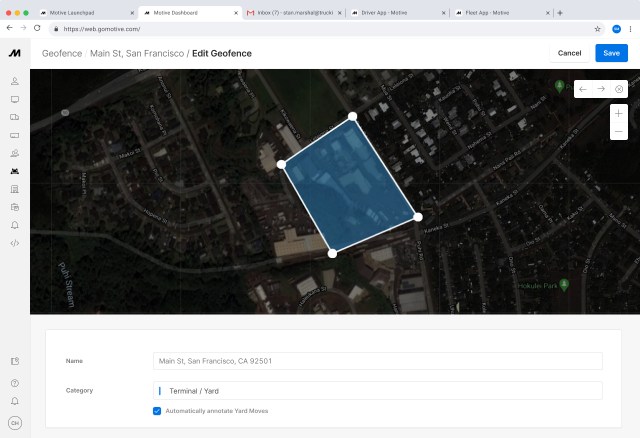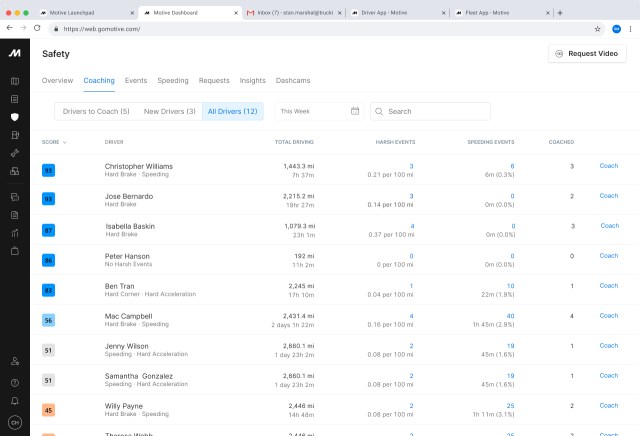At Motive, we use industry data to explore problems. One problem we recently tackled is: How can we help drivers drive more miles while remaining compliant? We uncovered insights about improving efficiency and driver safety that we can now pass to you.
But first, how did we arrive at this problem?
Industry average for driver turnover rate is up to 89 percent
Because driver retention is such a huge industry issue, we see a lot of data on the topic. For example, it costs, on average, $8,000 to lose a driver. We wanted to dig more into the available data and see what other insights we could glean.
According to the American Trucking Associations (ATA), turnover in 2018 for smaller fleets was 73 percent and for larger fleets was 89 percent. For mid-size fleets, 2018 fourth-quarter data showed a turnover rate of 78 percent.
Internally, we track the turnover rate of drivers who use Motive and compared it to the industry average. As of March 2019, our small-fleet drivers have a turnover rate of 47 percent, which is trending 26 percent less than average. Our large-fleet drivers have a turnover rate of 52 percent, which is trending 37 percent less than average.
Room to improve turnover in mid-size fleets
Motive drivers are faring well in the small and enterprise segments (at 26 percent to 37 percent better than the industry average) but our mid-size fleet data surprised us. Our drivers’ turnover rate of 69 percent in mid-size fleets is only 9 percent less than the last recorded industry average.
While that’s an improvement, we think we could be doing better, so we looked at other fleet data points. Third-party, independent testing showed that Motive is up to 50 percent easier to use than leading solutions.*
Perhaps we can learn about driver turnover from the way drivers and back-office staff use our app. Even if a fleet is using a different solution, thousands still use the Motive App.
Back-office managers seem to like us, too. Jim Jeter, Safety and Training Manager at Bee-Line Logistics says, “In the past, I’ve used a lot of other providers. They’re complex, hard to install, and hard to use. Today we use Motive and I wouldn’t use anything else.”
If our solution is easier to use and drivers and managers love it, why is our mid-market driver turnover nearly the same as the industry standard? Shouldn’t it be much less? Or maybe driver turnover is not a problem at all?
Adding capacity to the trucking network
According to ATA chief economist Bob Costello, the true problem is not necessarily drivers turning over, but adding capacity to the trucking network.
Another way to think about it: because drivers are in such high demand, they have plenty of career opportunities. When this happens, this highly-skilled workforce turns over to pursue jobs with the highest pay and best benefits. Pay is directly related to the number of miles a driver drives.
The real question for us to solve was: How do we increase the number of miles a driver can drive while keeping them compliant and safe?
Increase miles by improving wait times
One way to solve this problem is to improve dwell times at shippers, which can cost drivers over $1,280 per year and impact the number of miles they can drive.
Additionally, at ATA’s 2018 Economics Conference, Costello said that if a driver increases their miles from 8,500 to 9,000 per month, there would be a 5.9 percent increase in capacity and the driver would receive extra pay.
So we built a geofencing solution to give fleets actionable insight into detention time.

Fleet managers can pull reports to measure average detention times by location and identify ways to reduce costs. With this tool, fleet admins can alert their customers when a truck arrives at a given location and to get a jump the loading process and reduce dwell time.
Customers like Flying Star Transport already see results. Chief Financial Officer Jayson Boydston says,
“Motive’s geofencing and detention time reports helped us realize a 10 to 15 percent improvement on our efficiencies, measured by hours per load. We’ve gone from roughly five hours, last year, per load on a 130-mile haul and now we’re running about four hours per load on a 120-mile haul.”
Fleet data and safety
Wasted time at shippers not only costs fleets money, but just 15 minutes of extra dwell time can also impact safety, increasing the expected crash rate by 6.2 percent.
Truck drivers and trucking companies are often held accountable, even if they aren’t at fault. This fleet data is important to improving the safety of your drivers.
Coach drivers to be safer and more efficient with in-cab video
Video safety can prevent 63,000 large truck collisions per year and serve as the basis for your fleet’s safety program. A video solution like the Motive Smart Dashcam and coaching features can help exonerate drivers, saving time and money. It can also show at-risk drivers that need coaching.
Case in point: Motive customer Woodford Oil. Fleet and Safety Manager Norman Bright said, “Motive Driver Scorecards and Smart Dashcam footage have made our coaching much more effective. In four short months, we’ve seen a significant decrease in critical events, including hard braking events, cut in half.”
Motive’s safety and coaching solution automatically tags events so you can see trends and tailor driver coaching programs.

Turn fleet data into insights with Motive
Geofencing is the first of many offerings that make your location data work harder for you. Combine those tools with Motive’s Smart Dashcam and together we can help drivers focus on driving, staying compliant, and make the roads safer for everyone.
To learn more about our market-leading solutions read what our customers are saying or contact us today at 844-325-9230.
*Based on 3rd party independent testing against mobile and web apps of six other leading ELD providers measuring the time and/or ease to perform common tasks such as DVIR, and driver logs. Individual results and performance may vary. Cost and time savings based on an industry average rate per mile and an industry average administrative rate. Individual results and performance may vary.



